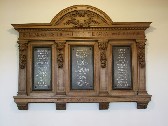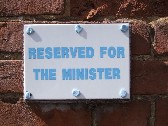| |
|
 |
|
This fine Victorian building
is part of the busy life of central
Ipswich. To be more precise, this is
really a collection of buildings, what
was known in the 19th Century as 'an
ecclesiastical village'. Perhaps the most
well-known of these is the red brick
former school, at the western end of the
site, which appears to be in pretty much
constant use. I know it well from
dropping my daughter off for brownies.
Secluded at the back of the site is that
rare thing, an urban non-conformist
graveyard. The church is today
known as Christ Church, and if you look
at the noticeboard you will see that its
denomination is Baptist/URC. In fact,
this building is now the home of several
former Ipswich congregations, who have
made their way here as their numbers
shrunk, and they sold out and moved in
here. Most of the other churches are now
lost to us, and so this building survives
as a memory of our Ipswich non-conformist
forebears.
|
The
frontage on to Tacket Street is rather clumsy,
the stubby towers appearing to serve no purpose.
In fact, if you had come this way before the
1970s you would have seen them surmounted by
elegant spires, but these have now gone. It would
be good to see them back, although understandably
aesthetics are generally not a priority of
non-conformist congregations. When the building
was opened in January 1858, it was as the home of
Tacket Street Congregational Church. But, in
fact, it was not the first church on the site.
Tacket Street is an ancient street - in medieval
times it was home to the town house of the
Wingfields, the last remnant of that building
being shamefully demolished as recently as the
1990s. Congregationalists had established their
first building on this site in the 1680s, at the
time of the Act of Toleration, which allowed
freedom of worship to all British citizens (as
long as they were not Catholics, of course). The
need for a new church was a symptom of the
triumph of Congregationalism over other
non-conformist denominations in East Anglian
towns in the middle years of the 19th Century.
During
the course of the next century and a half, Tacket
Street Congregational established itself as the
main focus of Congregationalism in what was its
natural habitat, a busy working class industrial
town. The building was extended eastwards towards
its near neighbour St Pancras at the start of the
20th Century. But after the Second World War, the
attractions of liberal non-conformism began to
pale, and so other congregations jumped ship to
here - there was the tiny rump of Ipswich
Presbyterians, leaving Portman Road church to
enter the new United Reformed church via the back
door of Tacket Street, and the shrinking
congregations of Crown Street Congregational, a
fine Grecian building demolished for offices,
and, more controversially, Turret Green Baptist
church. Because of the arrival of the Baptists,
Tacket Street Congregational was renamed Christ
Church, but the Baptists who come here must be
fairly liberal souls in comparison with the
militancy of many of their compatriots in
Ipswich's thriving Baptist churches.
| Along with the interior of
St Clement's Congregational church a few
hundred metres away, the interior of
Christ Church must be one of Ipswich's
best kept secrets. It is magnificent.
Best of all, the pews of the 1850s have
survived (you can see where the organ
used to be at the front, before it was
moved further east). The grand pulpit of
the earlier church survives, carved with
fruit and flowers in the Grindling
Gibbons style. It has a lockable door at
the back to prevent excitable ministers
from falling backwards down the steps. I
am told that there is a case being made
by some members of the church to replace
the numbered pews with modern chairs, but
this should be greatly resisted. The pews
here are one of the best examples of the
work of the decade in all England. The
gallery is superb - the best of any 19th
Century church in Suffolk. In the 1970s,
the interior was redecorated in vibrant
whites and blues. The lady who showed me
around regretted this, but I thought it
had been done extremely well - the white
paint of the gallery and roofs creates a
feeling of light and space that is
entirely successful, and unfamiliar. The
congregation here should be proud of what
they have done to maintain this building
into the 21st Century.
|
|
 |
|
|
|

